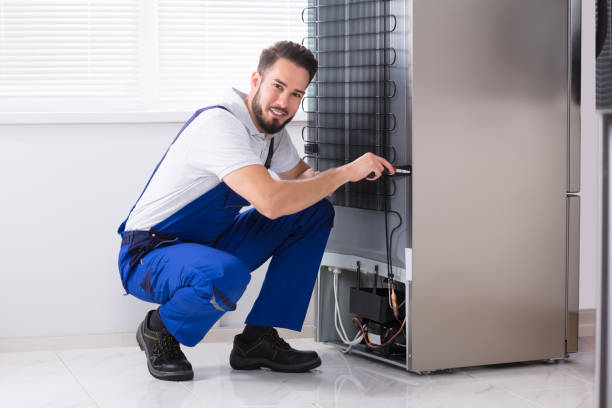Comprehensive Guide to Refrigerator Repair
Refrigerators are essential appliances in our homes, keeping our food fresh and safe. However, like any other machine, they can encounter problems. Understanding the basics of refrigerator repair can save you time and money. This guide will cover common issues, how to diagnose them, and steps you can take to fix them.
Common Refrigerator Problems
Refrigerator Not Cooling
One of the most common problems is when the refrigerator stops cooling. This can be due to several reasons:
- Dirty Condenser Coils: Over time, dust and dirt can accumulate on the condenser coils, reducing their efficiency.
- Faulty Evaporator Fan: The evaporator fan circulates cool air throughout the refrigerator. If it’s not working, the fridge won’t cool properly.
- Thermostat Issues: The thermostat controls the temperature. If it’s faulty, it can prevent the refrigerator from cooling.
Refrigerator Leaking Water
Water leakage is another common issue:
- Clogged Defrost Drain: The defrost drain can become clogged with food particles, preventing water from draining properly.
- Faulty Water Inlet Valve: If the water inlet valve is broken, it can cause leaks.
Strange Noises
Refrigerators can sometimes make unusual noises:
- Loud Compressor: The compressor might be making noise due to wear and tear.
- Fan Problems: The evaporator or condenser fan can become noisy if they are dirty or damaged.
Diagnosing Refrigerator Problems
Checking the Condenser Coils
- Locate the Coils: The condenser coils are usually found at the back or bottom of the refrigerator.
- Inspect for Dirt: Look for dust and dirt buildup.
- Clean the Coils: Use a vacuum cleaner or a coil brush to clean them.
Testing the Evaporator Fan
- Access the Fan: The evaporator fan is located in the freezer compartment.
- Check for Operation: Listen for the fan’s operation. If it’s not running, it may need to be replaced.
- Test for Continuity: Use a multimeter to check if the fan motor has continuity.
Thermostat Check
- Locate the Thermostat: The thermostat is usually inside the fridge compartment.
- Adjust the Settings: Try adjusting the thermostat settings to see if it changes the temperature.
- Test for Continuity: Use a multimeter to check if the thermostat is working.
Addressing Water Leaks
- Inspect the Defrost Drain: Check for any blockages in the defrost drain.
- Clean the Drain: Use a mixture of hot water and vinegar to clear the drain.
- Check the Water Inlet Valve: Inspect the valve for any signs of damage and replace it if necessary.
Steps to Fix Common Refrigerator Issues
Fixing the Condenser Coils
- Unplug the Refrigerator: Always unplug the refrigerator before performing any maintenance.
- Remove the Access Panel: If the coils are at the bottom, remove the access panel to reach them.
- Clean the Coils: Use a vacuum or coil brush to remove dirt and dust.
Replacing the Evaporator Fan
- Unplug the Refrigerator: Ensure the refrigerator is unplugged.
- Remove the Freezer Panel: Access the fan by removing the freezer panel.
- Disconnect the Fan: Disconnect the wires and remove the old fan.
- Install the New Fan: Connect the new fan and secure it in place.
Thermostat Replacement
- Unplug the Refrigerator: Safety first—always unplug the appliance.
- Access the Thermostat: Remove the cover to access the thermostat.
- Disconnect the Old Thermostat: Remove the wires and the old thermostat.
- Install the New Thermostat: Connect the new thermostat and secure it in place.
Fixing Water Leaks
- Clear the Defrost Drain: Use hot water and a mixture of vinegar to clear any blockages.
- Replace the Water Inlet Valve: If the valve is faulty, replace it with a new one.
Preventative Maintenance Tips
- Regular Cleaning: Clean the condenser coils every six months.
- Check Door Seals: Ensure the door seals are clean and free of debris.
- Set Correct Temperatures: Keep the refrigerator temperature between 37-40°F (3-4°C) and the freezer at 0°F (-18°C).
- Avoid Overloading: Don’t overload the refrigerator, as it can obstruct airflow.
When to Call a Professional
While many refrigerator repairs can be done at home, some issues require a professional technician:
- Compressor Problems: If the compressor is malfunctioning, it often needs professional repair.
- Refrigerant Leaks: Handling refrigerants requires special equipment and expertise.
- Electrical Issues: Any complex electrical problem should be handled by a professional.
Conclusion
Understanding the basics of refrigerator repair can help you troubleshoot and fix common problems. Regular maintenance can prevent many issues, keeping your refrigerator running efficiently for years. However, don’t hesitate to call a professional for more seriou


